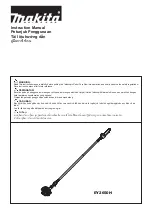
38
| English
1 609 92A 285 | (11.11.15)
Bosch Power Tools
Adjusting Mitre Angles
To ensure precise cuts, the basic adjustment of the machine
must be checked and adjusted as necessary after intensive
use (see “Checking and Adjusting the Basic Adjustment”,
page 42).
Always tighten the locking knob 15 firmly before saw-
ing.
Otherwise the saw blade can become wedged in the
workpiece.
Adjusting Standard Mitre Angles (see figure H)
For quick and precise adjustment of commonly used mitre an-
gles, detents
18
have been provided for on the saw table:
– Loosen the locking knob
15
in case it is tightened.
– Pull lever
16
and rotate the saw table
38
left or right to the
requested detent.
– Release the lever again. The lever must be felt to engage in
the detent.
Adjusting Any Mitre Angle (see figure I)
The mitre angle can be set in the range from 52° (left side) to
60° (right side).
– Loosen the locking knob
15
in case it is tightened.
– Pull lever
16
and at the same time, push mitre detent over-
ride
14
down at the front.
This locks lever
16
and the saw table can move freely.
– Turn the saw table
38
left or right by the locking knob until
the angle indicator
59
indicates the requested mitre angle.
– Tighten the locking knob
15
again.
– To loosen the lever
16
again (for adjusting standard mitre
angles), pull the lever upward.
The mitre detent override
14
snaps back to its original po-
sition and lever
16
can re-engage into the detents
18
.
Adjusting Bevel Angles
To ensure precise cuts, the basic adjustment of the machine
must be checked and adjusted as necessary after intensive
use (see “Checking and Adjusting the Basic Adjustment”,
page 42).
The vertical bevel angle can be adjusted in a range from 47°
(leftward) to 47° (rightward).
For quick and precise setting of frequently used bevel angles,
stops have been provided for the angles 0°, 22.5°, 45° and
47°.
Adjusting the Left-hand Bevel Angle Range
(45° to 0°)
– Pull the left fence extension
9
completely outward (see
“Extending the Fence”, page 37).
– Loosen the lock lever
17
.
– Tilt the glide arm via handle
4
leftward until the angle indi-
cator
33
indicates the desired bevel angle.
– Hold the glide arm in this position and tighten lock lever
17
again.
The clamping force of the lock lever must securely hold the
position of the glide arm at any bevel angle.
Adjusting the Righthand Bevel Angle Range
(0° to 45°) (see figure J)
– Pull the right fence extension
9
completely out-
ward (see “Extending the Fence”, page 37).
– Loosen the lock lever
17
.
– Lightly tilt the glide arm leftward out of the 0°position via
handle
4
and turn rotary knob
39
until the desired bevel
angle range is indicated.
– Tilt the glide arm via handle
4
to the right until angle indica-
tor
24
indicates the desired bevel angle.
– Hold the glide arm in this position and tighten lock lever
17
again.
The clamping force of the lock lever must securely hold the
position of the glide arm at any bevel angle.
Standard 0° Bevel Angle
To enable simple and swift resetting of the standard 0° bevel
angle, rotary knob
39
will engage in the bevel angle range
.
– Tilt the glide arm from right to left over the 0° position.
Adjusting the Complete Bevel Angle Range
(–47° to +47°)
– Pull both fence extensions
9
completely out-
ward (see “Extending the Fence”, page 37).
– Loosen the lock lever
17
.
– Lightly tilt the glide arm leftward out of the
0°position via handle
4
and turn rotary knob
39
until the
desired bevel angle range is indicated.
– Tilt the glide arm via handle
4
to the left or right until angle
indicator
33
or
24
indicate the desired bevel angle.
– Hold the glide arm in this position and tighten lock lever
17
again.
The clamping force of the lock lever must securely hold the
position of the glide arm at any bevel angle.
Standard 22.5° (see figure K)
– Pull adjustment knob
34
completely outward and turn it by
90°. Now, tilt the glide arm via handle
4
until the glide arm
can be heard to engage.
Starting Operation
Observe the mains voltage!
The voltage of the power
source must correspond with the data on the type plate of
the machine.
Switching On (see figure L)
– For
starting operation
, pull the On/Off switch
60
in the di-
rection of the handle
4
.
Note:
For safety reasons, the On/Off switch
60
cannot be
locked; it must remain pressed during the entire operation.
The glide arm can only be guided downward by pressing lock-
ing lever
5
.
– For
sawing
, the locking lever
5
must be pushed in addition
to pressing the On/Off switch.
To save energy, only switch the power tool on when using it.
Switching Off
– To
switch off
the machine, release the On/Off switch
60
.
Left
Right
0°
15°; 22.5°; 31.6°; 45°
15°; 22.5°; 31.6°; 45°; 60°
OBJ_BUCH-1360-003.book Page 38 Wednesday, November 11, 2015 2:13 PM
Summary of Contents for 3 601 M23 600
Page 4: ... 5 Bosch Power Tools 1 609 92A 285 11 11 15 ...
Page 5: ...1 609 92A 285 11 11 15 Bosch Power Tools 6 b2 b2 b1 b1 a GTA 3800 GTA 2500 W 15 16 12 12 12 ...
Page 7: ...1 609 92A 285 11 11 15 Bosch Power Tools 8 D C B2 B1 A 11 9 51 31 26 26 26 52 1 1 2 2 ...
Page 9: ...1 609 92A 285 11 11 15 Bosch Power Tools 10 L K J 34 17 39 60 5 4 1 5 2 4 3 ...
Page 10: ... 11 Bosch Power Tools 1 609 92A 285 11 11 15 P O N M 26 13 62 62 61 ...
Page 11: ...1 609 92A 285 11 11 15 Bosch Power Tools 12 T1 S R Q 36 63 35 29 30 4 5 26 60 5 4 ...
Page 12: ... 13 Bosch Power Tools 1 609 92A 285 11 11 15 T4 T3 T2 64 64 65 65 67 66 21 21 ...
Page 13: ...1 609 92A 285 11 11 15 Bosch Power Tools 14 W2 W1 V2 V1 U2 U1 68 70 71 72 69 ...
Page 14: ... 15 Bosch Power Tools 1 609 92A 285 11 11 15 Z Y X2 X1 73 75 17 74 37 4 19 19 76 7 ...









































